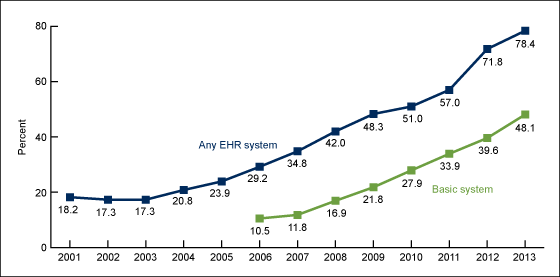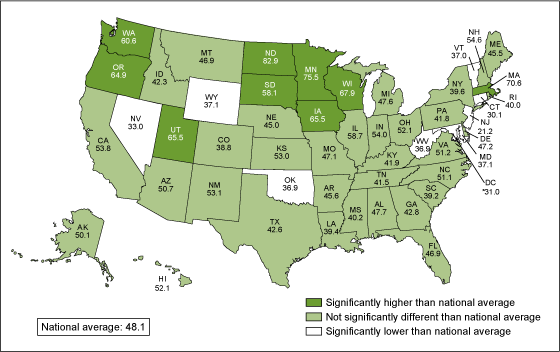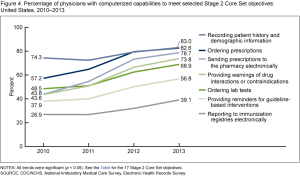 The number of physicians using electronic health record systems (EHRs) rose by 50% since 2010, from 51% to 78% of office-based doctors. That equates to about 4 in 5 U.S. physicians now using any EHR system. This growing adoption of EHRs is evident in the first chart, published in Use and Characteristics of Electronic Health Record Systems Among Office-based Physician Practices: United States, 2001-2013. This survey was published by the National Center for Health Statistics in the NCHS Data Brief Series in January 2014. (The NCHS is part of the Centers for Disease Control, aka the CDC).
The number of physicians using electronic health record systems (EHRs) rose by 50% since 2010, from 51% to 78% of office-based doctors. That equates to about 4 in 5 U.S. physicians now using any EHR system. This growing adoption of EHRs is evident in the first chart, published in Use and Characteristics of Electronic Health Record Systems Among Office-based Physician Practices: United States, 2001-2013. This survey was published by the National Center for Health Statistics in the NCHS Data Brief Series in January 2014. (The NCHS is part of the Centers for Disease Control, aka the CDC).
This growth rate hasn’t happened organically but has been fostered by the passage of the HITECH Act bundled into the Stimulus Bill, the American Recovery & Reinvestment Act of 2009 (ARRA). The HITECH Act provided for incentive payments directly to physicians who purchase and implement EHRs, based on meeting specific criteria spelled out in so-called Meaningful Use metrics. 2 in 3 U.S. physicians plan to participate in this incentive program as of 2013. However, most of those who intend to participate are not yet ready to meet the Meaningful Use objectives for the second stage (phase 2).
 The map illustrates the proportion of office-based doctors who have a basic EHR system by state, ranging from high adoption in the Pacific Northwest in Oregon and Washington, as well as the upper Midwest and Massachusetts. Average adoption is in the vast swath of the nation, with under-investment of EHRs in parts of the Northeast as well as Nevada, Oklahoma, West Virginia, and Wyoming.
The map illustrates the proportion of office-based doctors who have a basic EHR system by state, ranging from high adoption in the Pacific Northwest in Oregon and Washington, as well as the upper Midwest and Massachusetts. Average adoption is in the vast swath of the nation, with under-investment of EHRs in parts of the Northeast as well as Nevada, Oklahoma, West Virginia, and Wyoming.
 The third chart shows the percentage of physicians with computerized capabilities to meet Stage 2 meaningful use criteria. There are 17 core objectives in Stage 2 MU, including but not limited to recording patient history and demographics, ordering prescriptions, sending prescriptions electronically, providing warnings of drug interactions, ordering lab test, providing reminders for guideline-based interventions, and electronically reporting to immunization registries. Physicians’ readiness to meet these objectives varies from a high of 83% of doctors now prepared to record patient history and demographics and ordering prescriptions, to a low of 39% of doctors able to digitally report to immunization registries.
The third chart shows the percentage of physicians with computerized capabilities to meet Stage 2 meaningful use criteria. There are 17 core objectives in Stage 2 MU, including but not limited to recording patient history and demographics, ordering prescriptions, sending prescriptions electronically, providing warnings of drug interactions, ordering lab test, providing reminders for guideline-based interventions, and electronically reporting to immunization registries. Physicians’ readiness to meet these objectives varies from a high of 83% of doctors now prepared to record patient history and demographics and ordering prescriptions, to a low of 39% of doctors able to digitally report to immunization registries.
Health Populi’s Hot Points: The major challenges faced by doctors implementing EHRs vary by the physician’s practice setting and their “maturity” in using the EHR. Smaller physician practices (solo and those with fewer than 10 physicians) require a lot of assistance throughout EHR adoption as these practices don’t typically have IT support in-house, or experience with privacy and security, according to a just-published report from a team at ONC.
This is the first nationwide analysis of the issues behind the gap between the adoption of EHRs and the deep use of them. The report is published in the February 2014 issue of Medical Care journal, in A National Study of Challenges to Electronic Health Record Adoption and Meaningful Use by Dawn Heisey-Grove, et. al., from the Department of Health and Human Services’ Office of the National Coordinator, including the recently-departed head of ONC, Dr. Farzad Mostashari who joined The Brookings Institution. The researchers analyzed data from 55 Regional Extension Centers reporting experience among 43,000 health care providers. Issues fall into several categories, including: practice issues like workflow, training and staffing; vendor issues such as upgrades, certification, and lack of vendor support for training; attestation process issues, especially involving Medicare and Medicaid administration; and, meeting meaningful use measures.
In fact, Stage 1 of Meaningful Use has been largely successful, with physician practices getting bogged down in the second set of tactical objectives. As the new ONC Director Dr. Karen DeSalvo takes the helm at ONC, she will have the opportunity to inform, inspire and supports efforts for physicians to continue engaging more deeply in using EHRs with the purpose of driving better patient care — which is not the end-game of ticking off boxes.
In the meantime, we’ve work to do to inform U.S. health consumers that they have a right to ask for their EHRs. Dr. Harm Scherpbier, a doctor who works with physicians implementing EHRs, counsels people that “your doctor’s EHR is also yours.“




 Interviewed live on BNN Bloomberg (Canada) on the market for GLP-1 drugs for weight loss and their impact on both the health care system and consumer goods and services -- notably, food, nutrition, retail health, gyms, and other sectors.
Interviewed live on BNN Bloomberg (Canada) on the market for GLP-1 drugs for weight loss and their impact on both the health care system and consumer goods and services -- notably, food, nutrition, retail health, gyms, and other sectors. Thank you, Feedspot, for
Thank you, Feedspot, for  As you may know, I have been splitting work- and living-time between the U.S. and the E.U., most recently living in and working from Brussels. In the month of September 2024, I'll be splitting time between London and other parts of the U.K., and Italy where I'll be working with clients on consumer health, self-care and home care focused on food-as-medicine, digital health, business and scenario planning for the future...
As you may know, I have been splitting work- and living-time between the U.S. and the E.U., most recently living in and working from Brussels. In the month of September 2024, I'll be splitting time between London and other parts of the U.K., and Italy where I'll be working with clients on consumer health, self-care and home care focused on food-as-medicine, digital health, business and scenario planning for the future...